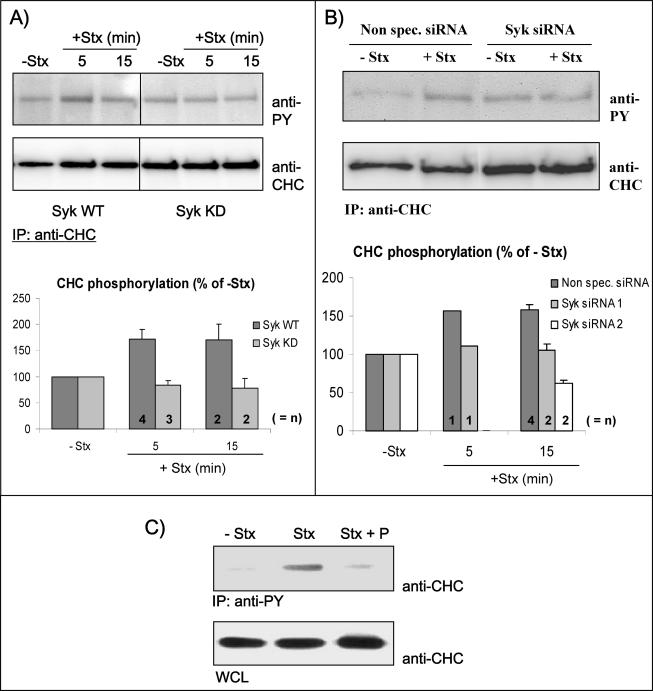Figure 3.
CHC phosphorylation results from Syk activation. (A) HeLa cells transfected with Syk WT or Syk KD were incubated with or without Stx for the different time points. The cells were lysed and clathrin was immunoprecipitated with anti-CHC antibodies overnight at 4°C. Finally, CHC tyrosine phosphorylation was monitored by Western blot analysis. The membrane was stripped and reprobed with anti-CHC to check equal loading of the material. Graph, quantification of the amount of phosphorylated CHC (after normalization for the amount of immunoprecipitated CHC). The error bars show the SEM (n = 3–4) or the deviation (n = 2) between the independent experiments. (B) HeLa cells transfected with nonspecific siRNA or Syk siRNA 1 were incubated with or without Stx (250 ng/ml) for 15 min. The cells were then lysed and immunoprecipitated as described in A. Graph, quantification of the amount of phosphorylated CHC (after normalization for the amount of immunoprecipitated CHC) from several experiments using both Syk siRNA 1 and Syk siRNA 2. The Syk mRNA level was reduced by 80–90 or 70–80% after transfection with siRNA 1 or 2, respectively. The error bars show the SEM (n = 4) or the deviation (n = 2) between the independent experiments. (C) Piceatannol inhibits tyrosine phosphorylation of clathrin. HeLa cells were pretreated with or without piceatannol (P) (50 μM) for 30 min and then incubated with 250 ng/ml Stx for 5 min at 37°C. The cells were then lysed, and proteins with phosphotyrosine were immunoprecipitated by using the slurry of an anti-phosphotyrosine (PY) column overnight at 4°C. The immunoprecipitates were analyzed by immunoblotting with mouse anti-CHC antibody. To show that equal amounts of cells were lysed and used for the immunoprecipitation, WCLs were loaded and analyzed.

